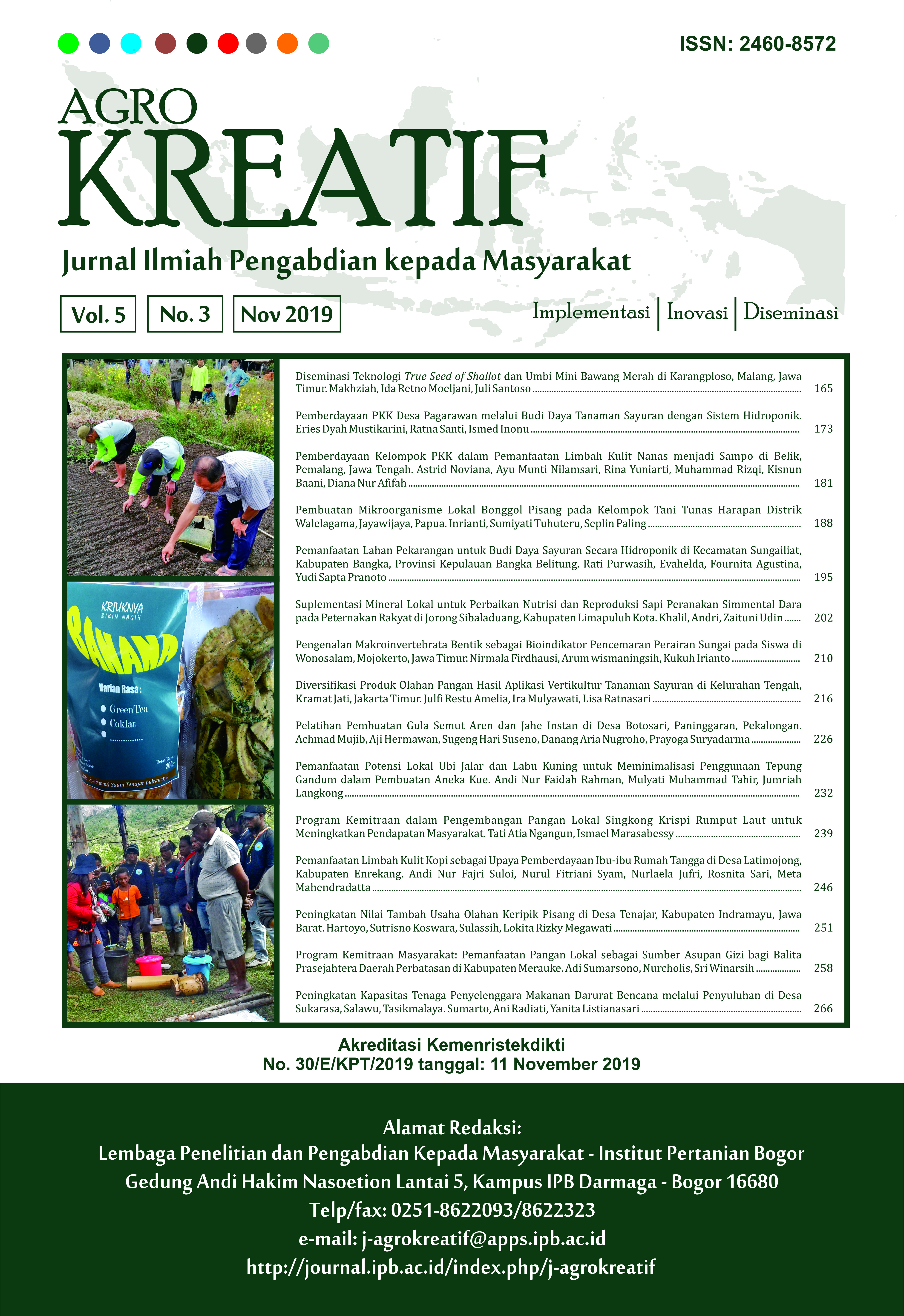Program Kemitraan dalam Pengembangan Pangan Lokal Singkong Krispi Rumput Laut untuk Meningkatkan Pendapatan Masyarakat
Abstract
Partner of the community partnership program on this study is a group of cassava chips processing located in the village of Ibra, Southeast Maluku district. Partners can be classified into economically productive societies, but they still face many problems in the production and marketing process. The purpose of this activity was to increase the income of the cassava chip processing group partners, and to increase the added value of cassava root by adding seaweed into high fiber cassava chips. The activity was carried out in three stages, firstly producing cassava flour with an improved press method, secondly producing cassava plates, and thirdly producing cassava krispi seaweed chips(SKRL). The results of the activity showed that SKRL products were quite attractive to consumers. With the improvement of the form, taste and packaging of SKRL had become one of the typical souvenirs of the Kei community. The marketing strategy adopted was to increase packaging using two types of packaging, namely primary packaging with propilen plastic (PP) and secondary packaging using paper boxes. Seaweed cassava produced was very preferred by consumers because it tastes good and crispy. The use of a screw press produced cassava chips with very low HCN levels so it is very safe to consume. The partner's income increased, the sales during the 6 months of activities reached 600 boxes with a value of IDR 10,000,000.Downloads
References
[AOAC] Association of Official Analytical Chemists. 2005. Official Methods of Analysis of AOAC International. Gaithersburg, Maryland (USA): AOAC International.
Almatsier S. 2009. Prinsip Dasar Ilmu Gizi. Jakarta (ID): PT Gramedia Pustaka Utama.
Burtin P. 2003. Nutritional Value of Seaweed. Electronic Journal of Environmental, Agricultural and Food Chemistry. 2(4): 498–503.
[DKP] Dinas Kelautan dan Perikanan Malra. 2015. Laporan Tahunan. Dinas Kelautan dan Perikanan Kabupaten Maluku Tenggara. Maluku Tenggara (ID).
Marasabessy I, Sudirjo F. 2017. Seaweed Fortification on Crisyi Enbal as Local Food of Kei Islands. IOP Conference Series: Earth and Environmental Science. Vol 89.
Marasabessy I, Sudirjo F. 2014. Peningkatan Daya Saing Enbal Crispi Sebagai Makanan Khas Daerah Maluku Tenggara Dengan Fortifikasi Serat Pangan Rumput Laut. Laporan Penelitian Hibah Bersaing (tahun 2). Tual (ID): Politeknik Perikanan Negeri Tual.
Mufreni ANF. 2016. Pengaruh Desain Produk, Bentuk Kemasan Dan Bahan Kemasan Terhadap Minat Beli Konsumen (Studi Kasus Teh Hijau Serbuk Tocha). Jurnal Ekonomi Manajemen. 2(2): 48–54.
Mukhtar S, Nurif M. 2015. Peranan Packaging Dalam Meningkatkan Hasil Produksi Terhadap Konsumen. Jurnal Sosial Humaniora. 8(2): 181–191.
Nurcahyo E. 2018. Pengaturan dan Pengawasan Produk Pangan Olahan Kemasan. Jurnal Magister Hukum Udayana.7(8): 402–417
Sitepu JM. 2009. Pengaruh Waktu Perendaman Terhadap Penurunan Kadar Asam Sianida (HCN) Pada Ubi Kayu Pahit (Manihot esculenta Grant). Medan (ID): Universitas Sumatera Utara.
SNI [1992]. Syarat Mutu Tepung Ubi Kayu. Standar Nasional Indonesia Nomor 01-2997-1992. Badan Standarisasi Nasional. Republik Inddonesia.
Tapotubun EJ. 2010. Diversifikasi Produk Enbal Cetak. Laporan Penelitian. Tual (ID): Politeknik Perikanan Negeri Tual. (tidak publikasi).
This work is licensed under a Creative Commons Attribution-NonCommercial 4.0 International License.
10.29239/j.agrikan.13.2.378-383
10.21070/ijccd2021697

















